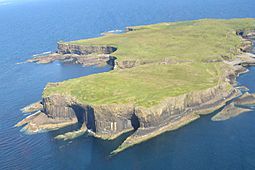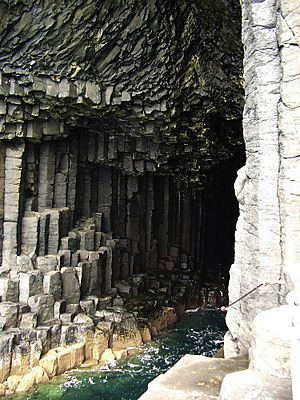Staffa facts for kids
| Gaelic name | Stafa |
|---|---|
| Norse name | stafi-oy |
| Meaning of name | Old Norse for 'stave or pillar island'. |
 Aerial view of Staffa, with The Colonnade in the foreground and Am Buchaille to the right |
|
| OS grid reference | NM323355 |
| Coordinates | 56°26′N 6°20′W / 56.43°N 6.33°W |
| Physical geography | |
| Island group | Mull |
| Area | 33 hectares (0.13 sq mi) |
| Area rank | 0 |
| Highest elevation | 42 metres (138 ft) |
| Administration | |
| Sovereign state | United Kingdom |
| Country | Scotland |
| Council area | Argyll and Bute |
| Demographics | |
| Population | Uninhabited since 1800 |


Staffa is a small, uninhabited island located off the northwest coast of Scotland. It's part of the Inner Hebrides islands. Staffa is most famous for its amazing Fingal's Cave and other cool rock formations. These rocks look like giant pillars!
Long ago, the island was part of a kingdom ruled by the Norse people for over 400 years. In 1266, Staffa became part of Scotland. Even then, no one lived on the island regularly.
Contents
The Island's Amazing Rocks
Staffa is a very special island because of its unique rocks. The whole island was formed by volcanoes millions of years ago. It has three main layers of rock.
The bottom layer is made of a soft rock called tuff. Above that, there's a thick layer of black, fine-grained basalt. On top of everything is another layer of basalt lava.
How the Pillars Formed
The most famous part of Staffa is its incredible columns. These pillars formed when the middle layer of basalt lava cooled down very slowly. As the lava cooled, it shrank and cracked into these amazing shapes. This process is called columnar jointing.
Most of the columns have six sides, making them look like giant hexagonal pencils standing upright. They also have cracks going across them, dividing them into sections. These columns form the walls and entrances of the island's famous caves, like Fingal's Cave.
Where Else Can You See Them?
You can find similar rock formations in other places too! The famous Giant's Causeway in Northern Ireland has very similar basalt columns. You can also see them on the island of Ulva and in a place called Ardmeanach on the Isle of Mull, which is close to Staffa.
These volcanic eruptions happened a very long time ago, about 55 to 58 million years ago!
Images for kids
See also
 In Spanish: Staffa para niños
In Spanish: Staffa para niños





